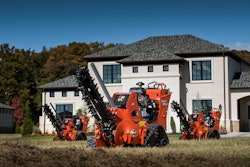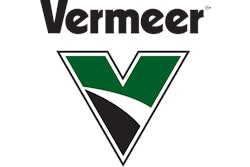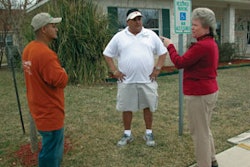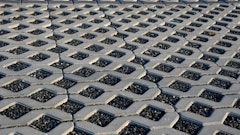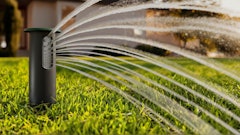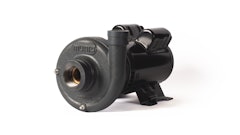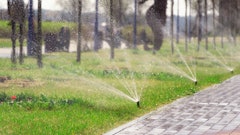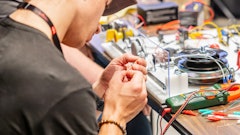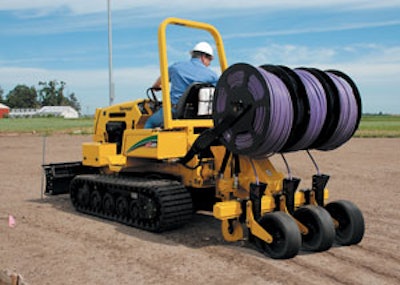
of drip irrigation pipe.
With hot, dry summers leading to ever-intensifying water restrictions, the need and demand for quality irrigation installation has increased. The trenchers used by landscape professionals to install irrigation systems have seen vast improvements in construction and efficiency. Landscapers are using trenchers and attachments to meet irrigation demand as well as expand their service offering.
Demand for dependable irrigation installation will continue to grow as the dry climate persists in certain areas of the country, upholding water restrictions. As Greg Adkins, trencher product manager for Ditch Witch, explains, the use of irrigation systems allows for better management of water. This, along with revised watering habits like watering in the early morning hours when there is less water evaporation, helps in abiding persistent water restrictions.
Jon Kuyers, utility product segment manager for Vermeer, agrees that these efforts will continue to be a requirement in many regions. “As the demand for fresh water increases regionally, conservation efforts will continue as people will be looking at their water footprint similar to the carbon footprint today,” explains Kuyers. “Early adopters of responsible irrigation are looking at different technologies to lessen the demand for water through using ‘smart’ irrigation control technology or subsurface drip irrigation that minimizes water loss through evaporation and run-off vs. conventional irrigation methods.”
As the demand for water-conserving irrigation continues to grow, the use of trenchers for installing irrigation systems is also on the rise. As a result, trenching equipment has seen improvements in construction, operation capabilities and purchase price. Manufacturers continue to seek new ways of improving cost and ease of operation in a time of such high demand.
REDUCING MAINTENANCE AND PURCHASE PRICE
As manufacturers observe growth in trencher usage, they have made consistent efforts to further develop equipment to offer users a higher-quality trencher for a low price. Brown Mfg. (TrenchMaster) has been achieving this through the clean construction of their equipment.
“We try to maintain our prices, keeping them as low as possible,” says Lee Campbell of Brown Mfg. “We manufacture our equipment to be uncomplicated and as low-maintenance as we can design it. The less complicated the machine, the lower the cost.”
By keeping the equipment construction as basic as they can while still providing a quality product, Brown Mfg. saves on the cost of construction, translating into a lower purchase price for consumers. The simple construction also reduces equipment maintenance requirements.
A new series of trenchers from Ditch Witch is also said to offer fewer maintenance requirements, thanks to their hydraulic drive. “The hydraulic trencher vs. mechanical allows easier operation for the operator and less maintenance than a typical mechanical trencher,” says Adkins. “The reduction of daily maintenance points is always a key element in the design of trenching equipment.”
The hydrostatic design on the Vermeer trencher also calls for less maintenance. “Vermeer has enhanced its trenching equipment through the use of hydrostatics,” explains Kuyers. “The hydrostatics help to simplify operation and reduce maintenance.” The hydrostatic-powered trencher and ground drive house fewer moving parts, adding up to less maintenance.
EASY OPERATION
Designing equipment to require less maintenance is only the foundation that manufacturers build off when constructing trenching equipment. They have also worked hard to make the landscaper’s job easier when operating the equipment. The construction and location of controls—a crucial element to trencher design—can greatly impact the ease of operation experienced by the user.
“The operator interface on the Zahn series, as well as all Ditch Witch trenchers, uses a standard color-coded system for operator controls,” explains Adkins. “With this system an operator moving from one machine to another can feel more comfortable and become more efficient in a shorter amount of time.” Vermeer trenchers also feature color-coded controls conveniently placed to the right of the operator’s seat. Ground Hog’s walk-behind trenchers also feature color-coded operator controls.
Maneuverability on the jobsite is also pertinent. The wheels on a Brown Mfg. walk-behind trencher were constructed after putting maneuverability into consideration. “Our trenchers have pneumatic tires,” says Campbell. “You can just roll them out there and do your job, and you’re in and out pretty quick.”
Similarly, the articulated steering on a Ditch Witch trencher affords users flexibility to meet the requirements of the jobsite.
A recent trend that has answered contractor requests is the weight of the trenching equipment. It adds to maneuverability both in operation and when transporting equipment to the jobsite. “Contractors are looking for a lighter machine so that one man can grab it and load it into a truck real easily,” explains Campbell. “It doesn’t take a crew or necessarily a trailer to get it on the jobsite.” Campbell adds that the lighter machines operate quicker, causing less wear on the operator.
CHOOSING EQUIPMENT AND ATTACHMENTS
While the lighter equipment may be very operator-friendly, users need to keep in mind the task at hand when choosing which trencher is right for the job. In deciding which trencher is the best option, users need to be sure of exactly what it will be used for. As an example, a lighter, more operator-friendly piece of equipment may not offer the same power as a heavier option. “If you get equipment that is too light, you can’t do the job a heavier machine can,” explains Campbell. “When digging in the hard ground, you need a machine with some weight.”
In addition to choosing the right size of equipment, there are many attachment options for contractors to pick from. “Users can find versatility with the multiple attachments available and reduce the need for separate independent machines to do specific work,” says Adkins. “The Zahn’s front end is arranged in a way that performance for different attachments is not compromised.”
In the past few years alone, Vermeer has developed attachments for the specific use and installation of drip irrigation pipe. “The MB40 plow attachment, which is now available on some of our walk-beside and ride-on tractors, allows contractors to install multiple rows of drip irrigation pipe simultaneously at the specified width and depths according to the soil type,” explains Kuyers. “This development has dramatically reduced installation time while increasing overall productivity.”
Ground Hog listed many other opportunities for landscapers to productively use trenching equipment and attachments to grow their service offerings. With a Ground Hog trencher and attachments, users can install residential lawn sprinkler systems, electronic dog fencing, low-voltage wiring (TV, cable, satellite dish), plumbing and drainage lines, landscape edging, silt fencing and also perform root pruning.
The service landscapers offer and the equipment they use also relates to the region in which they are performing their services. The type of grass, consistency of soil and the demand for certain services varies by region. Operation requirements as they relate to the region should also be considered when purchasing a trencher and attachments.
As the dry climate continues to fuel water restrictions, quality trenching equipment is essential to irrigation installation. As manufacturers carry on with improvements in equipment construction and capabilities, landscapers are choosing wisely, and purchasing trenchers and attachments that can add the most value to their service offering.




